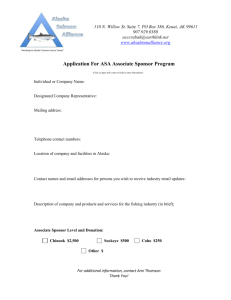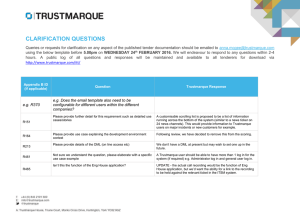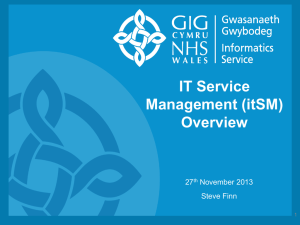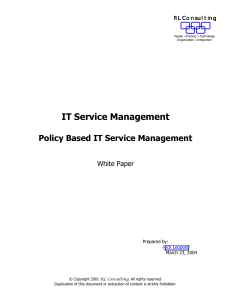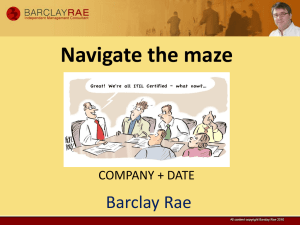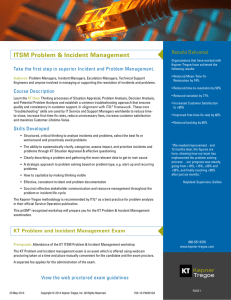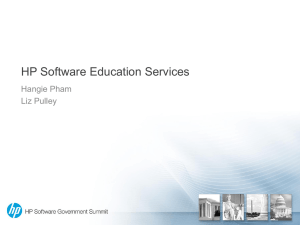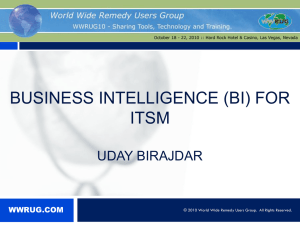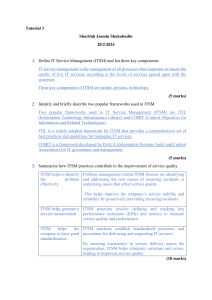Project Data Sheet - Draft for core Methodology
advertisement
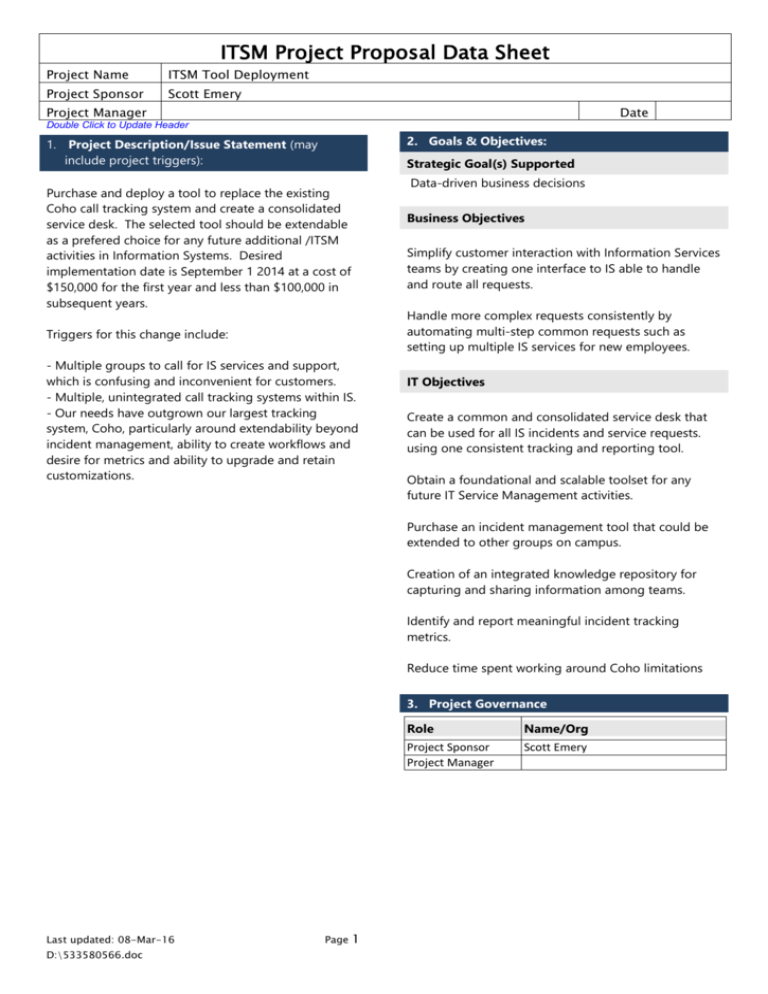
ITSM Project Proposal Data Sheet Project Name ITSM Tool Deployment Project Sponsor Scott Emery Project Manager Date Double Click to Update Header 2. Goals & Objectives: 1. Project Description/Issue Statement (may include project triggers): Strategic Goal(s) Supported Data-driven business decisions Purchase and deploy a tool to replace the existing Coho call tracking system and create a consolidated service desk. The selected tool should be extendable as a prefered choice for any future additional /ITSM activities in Information Systems. Desired implementation date is September 1 2014 at a cost of $150,000 for the first year and less than $100,000 in subsequent years. Business Objectives Simplify customer interaction with Information Services teams by creating one interface to IS able to handle and route all requests. Handle more complex requests consistently by automating multi-step common requests such as setting up multiple IS services for new employees. Triggers for this change include: - Multiple groups to call for IS services and support, which is confusing and inconvenient for customers. - Multiple, unintegrated call tracking systems within IS. - Our needs have outgrown our largest tracking system, Coho, particularly around extendability beyond incident management, ability to create workflows and desire for metrics and ability to upgrade and retain customizations. IT Objectives Create a common and consolidated service desk that can be used for all IS incidents and service requests. using one consistent tracking and reporting tool. Obtain a foundational and scalable toolset for any future IT Service Management activities. Purchase an incident management tool that could be extended to other groups on campus. Creation of an integrated knowledge repository for capturing and sharing information among teams. Identify and report meaningful incident tracking metrics. Reduce time spent working around Coho limitations 3. Project Governance Last updated: 08-Mar-16 D:\533580566.doc Page 1 Role Name/Org Project Sponsor Project Manager Scott Emery ITSM Project Proposal Data Sheet Project Name ITSM Tool Deployment Project Sponsor Scott Emery Project Manager Date Double Click to Update Header 4. Project Scope: Scope In Out Functional Acquire software supporting major ITSM functions. Deploying all aspects of IT Service Management. Establish a consolidated (single point of contact) service desk Assess and document current support processes Configure and deploy incident management solution. Retraining all IT staff in service methodologies. Train staff in use of solution. Ongoing/future tool customization Establish processes and expectations for use Duplicate all functionality of current call tracking tools Establish accounts and permissions for all IS employees involved in support functions Implementing future project phases System Least Flexible Last updated: 08-Mar-16 D:\533580566.doc All future users of ITSM tools or functions Resolve all issues uncovered by assessing current processes and user experiences Page 2 Most Flexible X Schedule Resources Moderately Flexible X Scope Gather ideas for future project phases Determine resource requirements for maintenance, customization service management and ongoing support Ongoing software upgrades and patches 5. Flexibility Matrix: Integrate tool with existing data sources for incident management All users of Coho, including Client Services, other IS departments and groups outside of IS. Purchase equipment, provision required infrastructure (systems, storage, database, etc.) or purchase for hosted solution. Provision for potential future growth. All other Scope Estimate ongoing support and maintenance costs Organizational Provide size and growth estimates. X ITSM Project Proposal Data Sheet Project Name ITSM Tool Deployment Project Sponsor Scott Emery Project Manager Date Double Click to Update Header 6. Key Project Deliverables 8. Staffing Estimates Role Acquire software to be used for incident, change, service, problem, configuration and release management. Sponsor 10% IS Leadership Team 10% Install (or work with service provider to activate) and configure incident management software to replace Coho. Core project team Project Team Lead 25% A baseline assessment of current state of IS service delivery. Infra. Svcs representative ECS representative Acad. Tech. representative Client services representative Technical Staff Programmer Establish processes and expectations for use Training, support and documentation for using software Turn off or obsolete Coho Estimated Start Date Assess current state Purchase software Gather configuration requirements Configure software Test configuration Train users Deploy (may be phased) Move to maintenance Estimated Finish Date All other milestones Last updated: 08-Mar-16 D:\533580566.doc Name/Org Scott Emery/Client Svcs Directors. To define business processes, promote change and address transition issues Lucas Friedrichsen/Client Svcs 10% 10% 10% 10% 10-20% To import/export data and/or customize Application owner 20% To configure solution System admin 5% If non-hosted Service owner 10% Vendor relationship, upgrades, etc. DBA 5% If non-hosted Trainer/documente 20% How-tos, training r information Other customer 5% Requirement gathering, teams testing, deployment 7. Preliminary Schedule and Milestones: Milestone Effort Date (mm/yy) 9. Service 9/1/2014 Page 3 Item Name/Org Owner (when project completes) Client Services ITSM Project Proposal Data Sheet Project Name ITSM Tool Deployment Project Sponsor Scott Emery Project Manager Date Double Click to Update Header 10. Financial Estimate (opt.) Total Costs 13. Known Issues and Risks (of proposal) Dollars Software modules difficult to operate independently. Initial Cost of Project TBD—out to bid Ongoing Annual Cost TBD—out to bid Total Benefits We deploy without sufficient thought to process, methodology or differing needs across IS groups, resulting in future rework or incompatabilities Dollars One-time Savings Annual Savings We fail to obtain sufficient buy-in from staff or customers. Funding Source Initial Costs: IS central software budget Ongoing Costs: Funding or resources not available for future support or maintenance needs. Benefit Description (e.g. revenue increase) The scope becomes more broad than the resources or culture will support. 11. Dependencies, Assumptions and Constraints Software is modular and functions can be deployed independently and integrated with other functions at a later time. IS is not attempting a full-scale implementation of IT Service Methodology at this time. Software may be installed at OSU or remotely hosted. 12. Project Performance measures (opt) Compare easy of finding services response to OCH surveys before and after project completes. 50% reduction in number of customer-facing contact names/numbers listed on IS web site. Last updated: 08-Mar-16 D:\533580566.doc Page 4 Project Data Sheet Appendix General note…doesn’t have to be just one page. 1. Project Description/Issue Statement Summarize the project and business problems to be solved. 2. Goals & Objectives Describe the major goals and objectives of the project from both a business perspective and an IT perspective, if relevant. [Note: clarify language that business objectives should be in terms of capabilities needed – not assets/IT language, etc] 3. Project Governance List the individuals assigned in directing the project 4. Project Scope Describe what is in and out of scope from a functional (boundaries around what the solution does), organizational (who is affected) and systems (which systems or infrastructure is involved) perspective. 5. Flexibility Matrix Assess where the flexibility will reside for the project to react to uncertainty as the portfolio is created. The assessment is relative between the three factors. 6. Key Project Deliverables List deliverables for the project in terms of business and process capabilities rather than in terms of changes to particular applications/assets. 7. Preliminary Schedule and Milestones List the anticipated start and end dates of the project. Include dates of required interim milestones as appropriate. 8. Staffing estimates List the estimated roles and % FTE required to complete the project (e.g 50% DBA, 10% web programmer). 9. Service Enter the proposed long-term owner of the delivered solution when the project completes. 10. Financial Estimate (summary of cost-benefit analysis) Under Total Costs, list the expected cost to deploy the project (include software, hardware, vendor costs, training, travel, marketing, etc.). List the expected annual cost to maintain the delivered solution (include maintenance fees, service costs, renewals, additional staffing, etc.) Under Total Benefits, list the expected income or recovery costs (people, hardware, software renewals, additional fees, etc.) Under Funding source, list the index/account, grant name or organization to provide funding 11. Dependencies, Assumptions, and Constraints List related project deliverables, important assumptions made, and imposed constraints. Note if the project's benefits are dependent on other project delivery dates, business projects/events or seasonal trends (e.g., in time for back-to-school). 12. Issues and Risks Document any anticipated issues and risks with the project that should be considered during portfolio planning.
